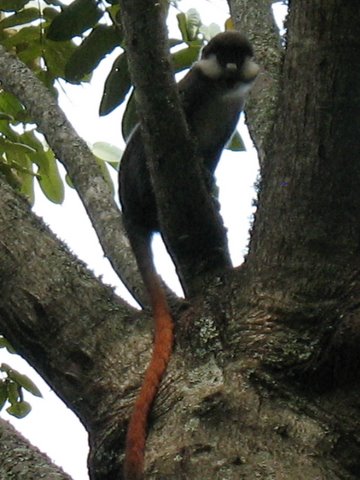Home
 About ITFC
About ITFC
 Impacts
and Achievements Impacts
and Achievements
 Completed MSc and
PhD projects
Completed MSc and
PhD projects
|
Feeding ecology and crop-raiding patterns of red-tailed monkeys (Cercopithecus ascanius) in Bwindi Impenetrable National Park . Flavia Natukunda, MSc thesis 2006
|
|

Crop-raiding animals
are one of the major issues around protected areas. The people around
Bwindi are poor. They lost full access to the forest when it was
gazetted a national park in 1991 and now they suffer crop raiding by
wild animals from the park. Crop raiding is not only a threat to these
people’s livelihoods but also to the conservation efforts in the park
since it is such a delicate issue between the local people and the park
management. All over Africa monkey species are declining due to habitat
destruction, hunting and live capture. To protect these species there is
a need to harmonize people’s opinion with park management practices.
This study was conducted between 2004 and 2005 to investigate the
feeding ecology and crop raiding patterns of Red-tailed monkeys (Cercopithecus
ascanius) in community land around Bwindi and to explore potential
mitigation strategies.
Feeding patterns of the Red-tailed monkey were observed during and
outside the fruiting season in the forest and compared with the feeding
pattern during harvesting seasons outside the park. The ‘Scan sampling
method’ was employed where one group of Red-tailed monkeys was monitored
from early morning (8:00 am) to evening (6:00 pm), from May to October
2005. All visible individuals of the group (adult males, adult females,
juveniles and infants) were considered. Behavioural data was collected,
including crop-raiding . In addition, informants were interviewed on
their experiences with crop-raiding monkeys. Mitigation measures
employed by farmers to crop raiding by Red-tail monkeys were also
compared.
Results indicated that Red-tailed monkeys spend most of their time
feeding (45%) and their ranging behaviour is determined by fruit and
crop availability. When there are no crops in the fields, the monkeys
spend more time inside the protected area, and outside of the fruiting
season monkeys spend more time looking for food. Overall crop-raiding by
Red-tailed monkeys was low and they could be called opportunistic
crop-raiders. Most (60%) of park officials interviewed reported not to
have found red-tailed monkeys raiding crops and 20% who were mostly
native game rangers reported to have found them raiding several times.
Guarding crops for more than six hours per day showed to be the most
effective measure farmers employ against crop raiding. But this is not
always feasible and a buffer of unpalatable crops like tea seemed
successful.
The author recommended mitigation measures like planting hedges with
Mauritius thorn, increasing yields through enhanced agricultural
practices and compensating people for their loss in crops with money
that has been generated through tourism. This would improve people’s
attitudes towards the protected area.
|
|
|
|


